GermGuardian AC4825 Review
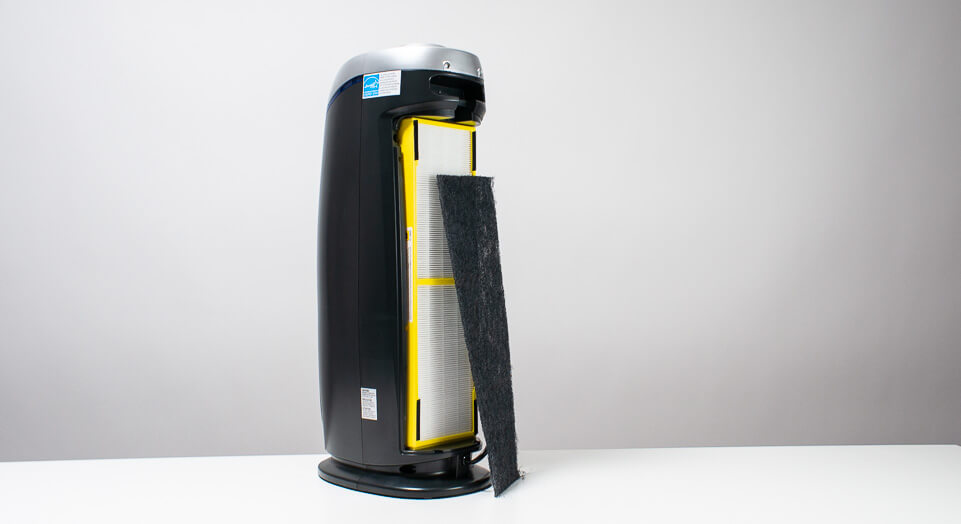
Feature Scores
Pros
- Good output for its price – to get to approx. 140 CFM you normally have to spend at least $100. This unit gives you that level of output for quite a bit less.
- A true HEPA filter for its price – many other air purifiers at this price have proprietary particle filters or HEPA type filters. This unit gives you true HEPA filtration for less than $100.
Cons
- Carbon filter is poor quality – this makes the AC4825 a poor option if gas filtration is important to you
- UV light is likely ineffective – bulb wattage is very low and placement of the light is suspect
Editor's Score
| Particle filter type | HEPA |
|---|---|
| Gas filter type | Carbon |
| Pre-Filter | No dedicated filter - carbon filter doubles as pre-filter |
| Output | Approx. 140 CFM |
| Air Movement | back grille > carbon filter > HEPA filter > outlets on front of unit |
| Number of fan speeds | 3 – low, medium, high |
| Size | 22 in. tall x 7 in. wide x 10 in. deep |
| Weight | 8 lb. |
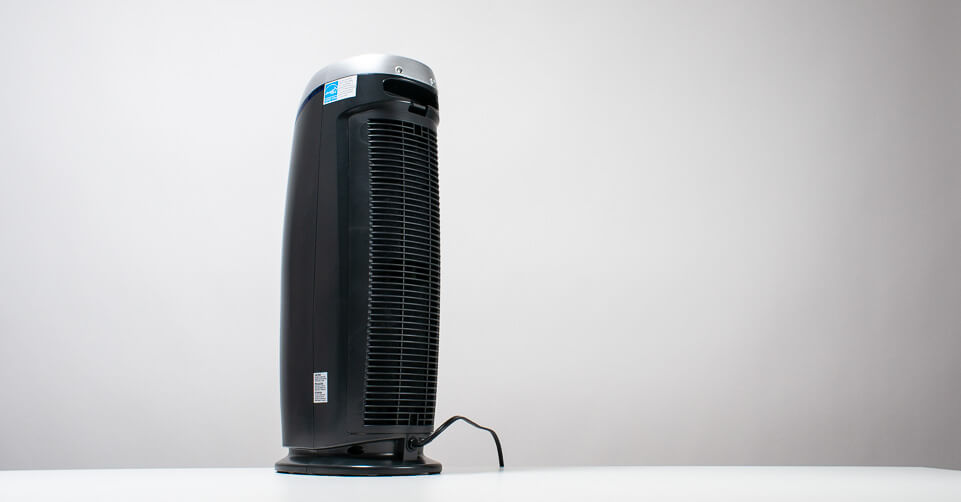



Analysis
A step by step breakdown of the AC4825's performance.
Air Processing Performance
Test Results
In a 150 sq. ft. test environment, the AC4825 took 23 minutes to lower room particle concentration from 10,000 down to 1,000 particles per cubic ft. The former concentration (10,000) is relatively “dirty” air while the latter concentration (1,000) is relatively clean air.
This time (23 minutes) was expected considering the AC4825’s HEPA particle filter and output of approx. 140 CFM (meaning it can process approx. 140 cubic feet of air per minute). For comparison, the GermGuardian AC4300, also equipped with a HEPA filter and the same approx. output (CFM), took 26 minutes. The Honeywell HPA100, also equipped with a HEPA filter and the same approx. output, took 22 minutes.
Higher CFM units were slightly faster. For example, the top rated 250 CFM HEPA equipped Coway Mighty and Winix 5500-2 each took 9 and 10 minutes, respectively.
The second part of our particle testing involved allowing the air purifier to continue to run for several hours to see just how low of a particle concentration it would be able to achieve given an unlimited amount of time. The lowest room particle concentration the AC4825 was able to achieve was 500 particles per cubic ft. It took an additional 40 minutes on top of the initial 23 minutes to reach this concentration starting at 10,000 particles per cubic ft. Past this additional 40 minutes particle concentration would continue to oscillate between 500 and 1,000 particles per cubic ft. 500 particles per cubic ft. was the absolute lowest concentration this unit was able to achieve.
For comparison, the lowest concentration the GermGuardian AC4300 and Honeywell HPA100 were able to achieve was 900 particles per cubic ft. Higher CFM units like the Coway Mighty and Winix 5500-2 were able to achieve a lower concentration of 100 particles per cubic ft.
The bottom line here is that the AC4825 lowers room particle concentration just about as fast and just about as low as comparable models with the same type of particle filter (HEPA) and similar output. Higher CFM HEPA equipped units lower room particle concentration faster and to lower levels.
Filter Analysis
Particle Filter
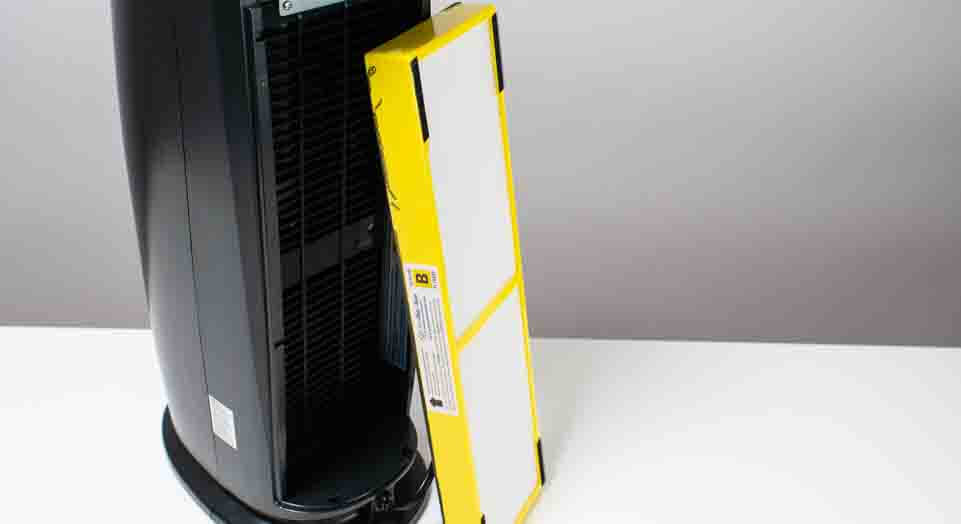
The AC4825 is equipped with a HEPA filter for the purpose of particle filtration (removing pollen, dust, mold spores, etc.). HEPA filters are the industry standard for particle filtration as they’re highly efficient and extremely effective. A HEPA filter removes 99.97% of particles that travel through it on the first pass. That means that only 3 in every 10,000 particles make it through a HEPA filter on the first pass.
The fact that the AC4825 comes equipped with a HEPA filter at its price point is impressive. Many other units in the same price range come equipped with HEPA Type filters (an imitation of HEPA filters) or a proprietary particle filter (a brand specific particle filter that doesn’t have HEPA level efficiency). The Blue Pure 411 is an example of such an air purifier. It comes equipped with a proprietary particle filter with an efficiency of 99% (compared to 99.97% for HEPA).
More expensive air purifiers have the exact same type of particle filter – HEPA – as the AC4825. The Coway Mighty and Winix 5500-2 each come equipped with a HEPA filter. Even the more expensive Coway AirMega comes equipped with a HEPA filter. High end Rabbit Air air purifiers come equipped with HEPA filters.
The HEPA filters in these larger more expensive units have similar construction with the exact same efficiency rating (99.97%) as the HEPA filter inside the AC4825. The primary difference between them is size. The AC4825’s filter is much smaller.
Gas Filter
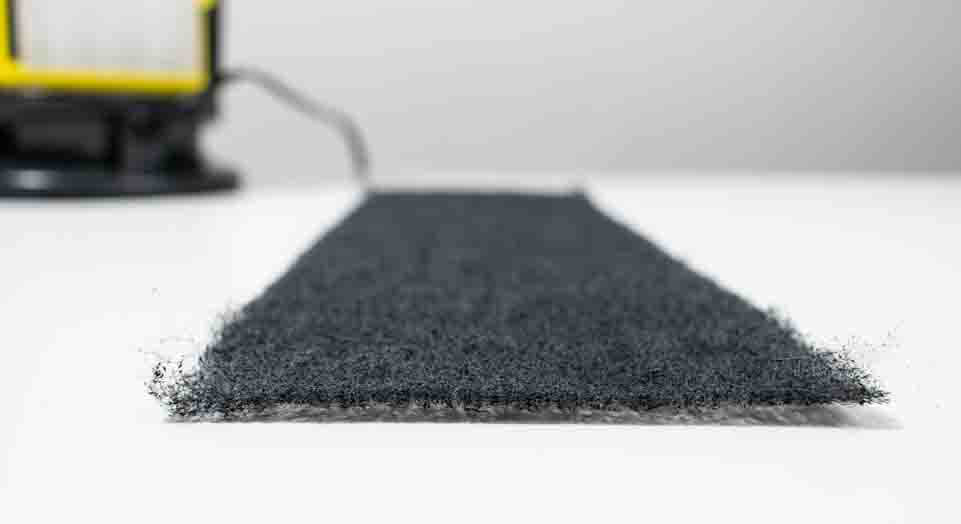
The AC4825, much like most other air purifiers on the market, comes equipped with an activated carbon filter for the purpose of unwanted gas filtration – removing VOCs, odors, etc.
The AC4825’s carbon filter is comprised of a fibrous material that’s simply coated with carbon. This type of carbon filter is quite common in low to mid tier air purifiers. The AC4300, Honeywell HPA100, Blue Pure 411, even the Coway Mighty have this same type of carbon filter.
Certain mid and most higher tier units have carbon filters that contain actual carbon pellets. The Winix 5500-2 is a mid tier example of a unit that comes equipped with this type of carbon filter. The Coway AirMega and Rabbit Air air purifiers are higher tier examples.
This second type of carbon filter – one that contains actual carbon pellets – is the superior option for gas filtration. Thus, if gas filtration is a priority for you, definitely look to buy a unit that has this type of carbon filter installed (like the Winix 5500-2) instead of one that has the fibrous type installed (like the AC4825).
Another important point we need to make about the AC4825’s carbon filter is the fact that it’s of a lower overall quality than fibrous carbon filters installed on most other air purifiers we tested.
It’s much less dense. That is to say, fibers on the AC4825’s carbon filter are more spread apart than they are on most other fibrous carbon filters we tested. The fibers are also loosely held together - so loosely that fibers would break off of the filter when we removed it from the Velcro holding it in place inside the air purifier. Note that this was an issue on all GermGuardian air purifiers we tested. The AC4300 had the same issue.
The bottom line here is that the AC4825 is a poor option if gas filtration is a priority for you. It compares poorly to other units equipped with a fibrous carbon filter and especially units equipped with a pellet based carbon filter.
Pre-filter
To make matters worse, the AC4825’s carbon filter doubles as the unit’s pre-filter. So it’s purpose is not only to remove unwanted gases, but also to remove larger particles (this, in effect, prevents larger particles from saturating the HEPA filter too quickly).
This setup is quite common in lower tier air purifiers. The Honeywell HPA100, GermGuardian AC4300, and many other units in the same price range have the same setup – a carbon filter that also acts as a pre-filter.
More expensive units have a separate washable pre-filter. The Coway Mighty and Winix 5500-2 both have this type of pre-filter. The advantage here is that the pre-filter can be washed instead of needing to be replaced at cost (the carbon filter on the AC4825 has to be replaced at cost).
UV
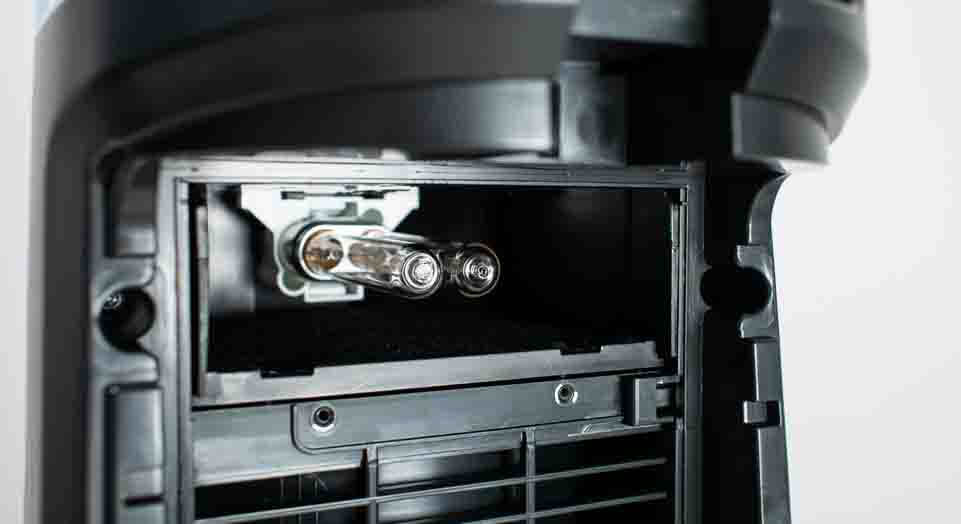
The AC4825 does come equipped with UV functionality although it’s poorly implemented. First of all, the UV light bulb is a very low power bulb. It’s only 5 watts. Second, the UV light sits inside a shielded compartment at the top of the air purifier. On the AC5250PT the UV light is fitted lengthwise down the whole intake side of the air purifier. All air moving through the intake is exposed to this light. On the AC4825 the light is in a separate compartment. We find it highly questionable that any light at all reaches intake air on the AC4825. And even if it does, the air’s exposal to that UV light would be minimal.
The good news here is that you really don’t need UV light to kill germs. The germs get filtered out of the air by the unit’s HEPA filter regardless of whether they’re dead or alive.
Thus, the unit’s lack of a properly implemented UV light is inconsequential. Even if it did have a properly implement UV light it’s not necessary to filter germs.
Air Movement
The GermGuardian AC4825 outputs at approx. 130 to 140 CFM. Taking into account other factors like particle filter type, gas filter type, and its performance in our testing, this gives it sufficient air processing power for rooms up to about 150 sq. ft.
Note that the unit has to be set to maximum fan speed to effectively reduce and maintain low particle concentration in a 150 sq. ft. space. The area of coverage is greatly reduced on lower fan speeds. On medium, the unit shouldn’t be used in rooms larger than 100 sq. ft. On low it cannot properly clean the air in a space larger than about 80 sq. ft.
Top rated 250 CFM units like the Winix 5500-2 and Coway Mighty can be used in rooms up to 300 sq. ft. on high fan speed and 80 to 150 sq. ft. on lower fan speeds.
Energy Efficiency
The AC4825 demonstrated average energy efficiency compared to other units in the same size class. Its power draw was measured at 44.2, 38.2, and 34.2 watts on high, medium, and low fan speed. Turning on the UV light added about 4 watts.
For comparison, most other 100 to 150 CFM units we tested also had a power draw between about 20 and 50 watts, depending on fan speed. This gives these units a CFM/watt ratio of 2 to 3, depending on exact model and exact fan speed.
Higher CFM units were generally more energy efficient, especially on lower fan speeds. The Coway Mighty, for example, draws less than 10 watts on medium and low. On medium, it still outputs at approx. 100 CFM. This gives it a CFM/watt ratio of 13 on medium. On high it draws 72.3 watts of power but outputs at approx. 250 CFM for a ratio of 3.4.
The bottom line here is that higher CFM units like the Coway Mighty are generally a better option than lower CFM units like the AC4825 if energy efficiency is a priority for you.
Noise Output
The AC4825 did quite well in our noise output tests. It was measured at 61.2, 54.8, and 44.2 dB on high, medium, and low fan speed. For comparison, most other lower CFM air purifiers we tested garnered similar results. The AC4300 was slightly quieter – measured at 58.6 dB on high. The Blue Pure 411 was slightly louder – measured at 65.4 dB on high. But you’d be hard pressed to distinguish a difference in noise output between these three units without the help of a sound meter.
Higher CFM units are slightly louder on their highest fan speed but they do have close to double the output. The Coway Mighty was measured at 66.1 dB and the Winix 5500-2 was measured at 67.5 dB on their highest fan speed at approx. 250 CFM of output.
On lower fan speeds high CFM units truly shine in the category. For example, both the Winix and Coway were measured at only 48.9 dB on their second highest fan speed. On this setting they still output at approx. 100 to 120 CFM. This means that you can run these units on their second highest fan speed in smaller rooms (up to 150 sq. ft.) very quietly to lower and maintain low particle concentration and in larger rooms (up to 300 sq. ft.) to maintain low particle concentration (after running them on their highest fan speed to lower it).
In summary, the AC4825 is just about as quiet as competitors in the same price range and at approx. the same output. However, it doesn’t compare as favorably to higher CFM units. If you’re looking to lower and maintain low particle concentration in a 150 sq. ft. room, a higher CFM unit like the Coway Mighty operating on lower fan speeds is far quieter than a lower CFM unit like the AC4825 operating on maximum fan speed.
Durability
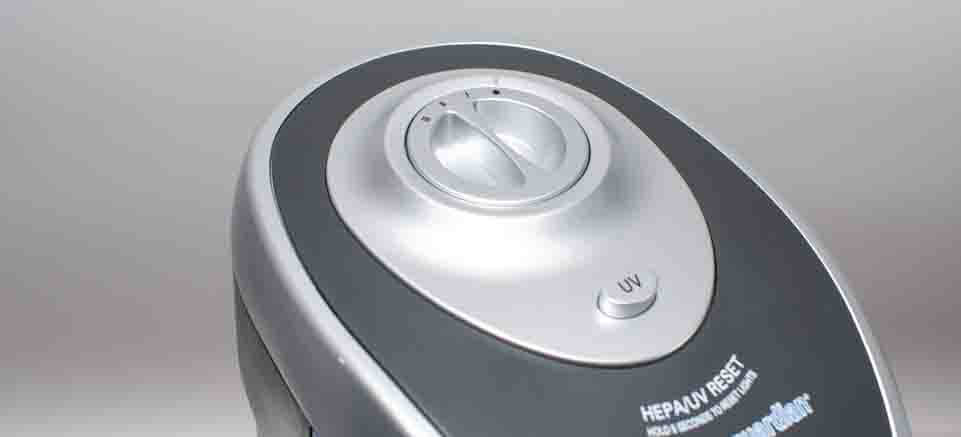
The AC4825’s build quality matches its price of approx. $80. That is to say, its build quality is good for the price but not as good as the build quality of more expensive options.
The unit does come with a 3 year warranty. More expensive options often have longer warranties although that is not the case for the two top rated units we’ve mentioned repeatedly throughout this review. The Coway Mighty also comes with a 3 year warranty and the Winix 5500-2 only comes with a 1 year warranty.
Is this the most durable air purifier we tested? No, not even close. But it’s very cheap. And it’s build quality is more than sufficient considering its very low price. If the unit does break, it can be fully replaced fairly inexpensively, even outside of warranty.
Ease of Use
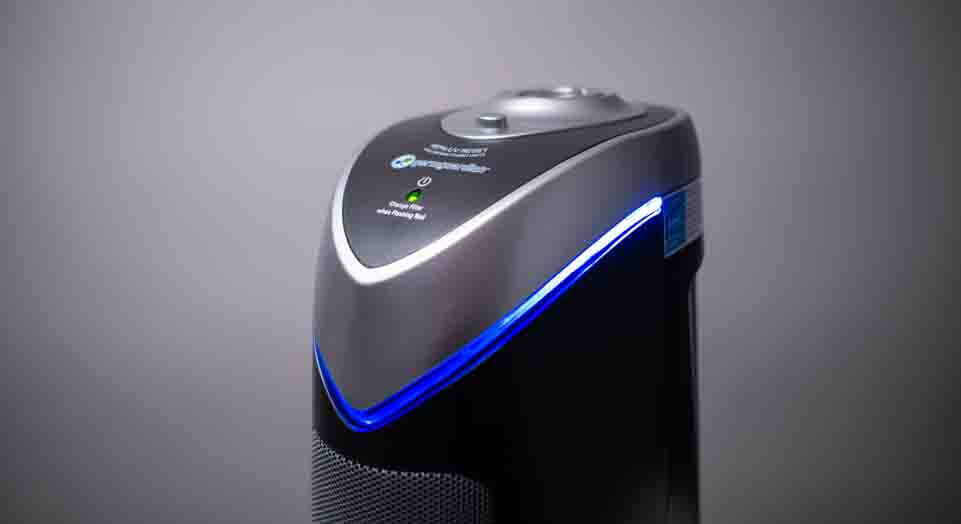
A single LED illuminates a green light on the top of the unit when you turn the air purifier on. LEDs also illuminate a thin ring of blue light around the top of the unit when you turn on UV functionality. UV on this unit is poorly implemented so it’s unlikely that you’ll want to turn the UV on to begin with. However, the green light on the top of the unit will always be on so be aware of this if you plan on using the unit in a dark room and you’re sensitive to lights illuminating in the room at the same time.
Note that most other air purifiers on the market also have LEDs that cannot be turned off. The top rated Winix 5500-2 and Coway each have even more lights that illuminate and those lights cannot be turned off.
If you’re looking for an option in the price range that has control panel lights that can be turned off, both Honeywell HPA series units and most Levoit units offer this functionality.
The AC4825 is much smaller and more compact than what it looks like in photos online. The unit looks like it’s the size of a standard tower fan in photos, but it absolutely is not. It’s much smaller. The unit is about 22 inches tall but only 7 inches wide and 10 inches deep. A full size air purifier like the Winix 5500-2 is taller, wider, and deeper (24 x 15 x 8).
The AC4825 is also light. It weighs just over 8 lb. The Winix 5500-2 weighs 16.5 lb.
This GermGuardian air purifier, like most other units in the same price range, has a very basic design and lacks many features you find on more expensive options. The unit lets you set it to 3 different fan speeds and turn UV functionality on/off. That’s it.
More expensive options like the Winix 5500-2 and Coway Mighty have a timer, a particle concentration sensor, and a corresponding auto mode. Not to mention extra modes like a sleep mode and/or eco mode. The Winix also comes with a remote and one extra fan speed.
Value
The GermGuardian AC4825 is cheap, retailing for approx. $80. But that doesn’t necessarily make it a good value. Value is about the price you pay but also about what you get for the price you pay.
And what you get with the AC4825 is just about what you would expect at its price point, giving the unit only average value compared to other options on the market.
The AC4825 has major shortcomings:
- its gas filtration is highly limited
- it doesn’t have a separate washable pre-filter
Beyond these two things it offers very average performance in all categories.
Does this make it a bad buy? No, it absolutely does not. But be aware that you get what you pay for with this unit. And that’s an air purifier that certainly will get the job done in smaller rooms (up to 150 sq. ft.) where particle filtration is the only requirement. But not beyond that. Do not expect this unit to have anywhere close to the same level of performance as more expensive full size options.
A full size approx. $150 option like the Winix 5500-2 offers far superior gas filtration (because of its pellet based carbon filter), better particle filtration (because of its higher CFM), a separate washable pre-filter, much better energy efficiency, and quieter operation.
So, which option should you go with? That depends on needs and budget. If you only require particle filtration in a smaller room, you can get away with the AC4825 at approx. $80. If you want a much better all-around option that offers superior filtration and overall functionality, something like the Winix or Coway Mighty is the better option in the $150 to $200 range.
Add a Comment
Have a question or comment? Let us know below.

Comments (2)
I was wondering what the filters cost.
what about the T102 in the unit heard this isn't safe??